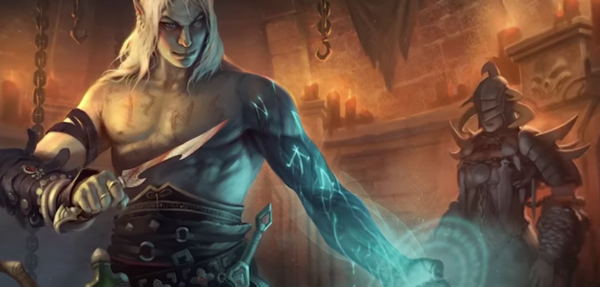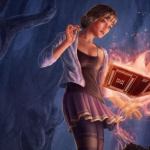Illusion Spells are designed to deceive the sense of those around you, allowing you to distort reality in any way that you deem as useful. Given that this is the purpose of Illusion as a school of magic, it should come as no surprise that the spells on the Illusion spell list are primarily control and utility leaning and tend to be more useful outside of combat than in it.
Still, perhaps more than any other school of magic, Illusion spells provide you with as much value as your creativity (and DM) allows. There are five 1st level Illusion spells in 5th Edition Dungeons & Dragons. Each of these spells have their place in the game, but some could potentially be game breaking if used to full effect.
5. Illusory Script
Illusory Script is a ritual spell that allows you to imbue a message written on a suitable writing material, such as paper or parchment, with an illusion that lasts for the next 10 days, allowing you and creatures of your choice to view the message as written, while simultaneously concealing the true message from any other creature that sees the writing material.
When you do this, you can choose to either make the message appear to be written in unintelligible language, a different language that you know, or to be an entirely different message altogether.
Unless you are new to D&D or have played in some very creative social-facing campaigns, it should come as no shock to you that this spell ended up at the bottom of this list. Just how often you will be in a situation where you need to hand someone a message that says one thing to someone, and another thing to someone else is hard to gauge, but chances are it is not going to come up every day.
As far as value goes, getting 10 days of use out of a ritual spell is a pretty nice bargain, but when you factor in the 10-gold-piece cost of material and the remarkably limited usefulness of disguising written messages, it is hard to make the argument that this spell is worth preparing, unless you are playing in a campaign where political intrigue, deception, and handing written letters back and forth are central factors to your party’s success.

4. Color Spray
Color Spray allows you to shoot out colored light from your hand, dealing no damage, but blinding 6d10 hit points of creatures within a 15-foot cone of you until the end of your next turn. Blinded is a condition that can severely debilitate an enemy in combat, giving them disadvantage on attack rolls, causing them to fail any ability check that requires sight, and giving any creature that attacks them advantage on the attack roll.
Being able to invoke this condition without so much as a saving throw sounds like an incredibly effective debuff, but where this spell really falls short is in the way in which its effectiveness is determined. 6d10 hit points averages out to be 35.
With a 15-foot cone area, you aren’t very likely to blind more than a couple of enemies with this spell at a time, and to make matters worse, their vision will return automatically by the end of your next turn.
It definitely could be useful if you are surrounded by a horde of incredibly weak enemies, but even if that happens to be the case, there are a lot of cooler and more effective options for controlling and debuffing enemies, even at 1st level.
3. Disguise Self
Disguise Self does exactly what it sounds like it does. It allows you to transform the way you look, along with your armor, weapons, clothing, and other belongings. You can even make yourself look taller or shorter, and leaves all of the details of how your disguise looks completely up to you. The disguise lasts for an hour, and for anyone to see through it, they need to make an investigation check against your spell saving DC.
This is actually a lot of utility for a first level spell slot, and Disguise Self really gets down to what the school of Illusion is all about. Not only is it almost just as useful at later levels as it is at earlier ones, but it’s also open-ended, fun, and leads to finding interesting and creative solutions to problems that would otherwise be repetitively smashed, bashed, and mindlessly rolled through.
If I were ranking the enjoyment you could get out of a first level spell, this would probably be at the second from the top spot on the list for 1st level Illusion spells, and given how fun Illusion spells are to cast, that makes it close to the top spot for all 1st level spells. I have personally seen Disguise Self used in a variety of ways that completely changed the game for the better.
As opposed to other very functional and mechanically appealing spells that deal a lot of damage or debilitate your enemies, the usefulness of Disguise Self is very nuanced, and is almost entirely reliant on your description and the DM’s willingness to play along. That is the reason for this receiving a spot in the very middle of this list. It could really go either way, and there is nothing about it in particular that guarantees its usefulness. I have been in campaigns where it was used almost every session, and campaigns where it almost never made a meaningful difference.

2. Distort Value
Distort Value is an interesting, if not potentially broken option. It allows you to use illusions to double an object’s perceived value for the next 8 hours. A creature can determine the item’s true value only with a successful investigation check against your spell save DC.
The limiting factor of this spell is that it only allows you to cast this effect on an item that is no more than 1 foot on a side, unless cast at a higher level, which will increase the maximum size by 1 foot per additional spell level.
The optimal use of this spell is fairly straightforward: find something valuable to cast it on and sell it to an unaware merchant for double the value. If your DM allows you to sell magical items, this could get very broken very quickly, and even if they don’t, you can still use this ability to make a lot of gold.
Of course, the downsides are largely up for interpretation by the DM as well. For instance, many merchants will not be happy about being conned out of their hard-earned gold. Just how aggressive and dangerous these spurned merchants are is going to be up to the DM to determine, and it may actually lead to some significant problems for your party down the road, so be aware of the possible downsides and use this spell with caution.
1. Silent Image
At number one on the list for best 1st level Illusion spells is Silent Image, which is a spell that allows you to create an image of an object, creature, or other visible phenomenon that is no larger than a 15-foot cube. You can place this image at a spot within 60 feet of you, and the spell requires concentration, lasting for a potential 10 minutes. As an action on subsequent turns, you can move the image to any spot within 60 feet, in a way that seems completely natural.
The downsides with Silent Image are that: 1. It is silent. And 2. It is just an image. That means that you can’t use it to make any noise or interact with a creature in any tangible way. In fact, and physical object that touches the image will pass right through it, revealing it to be an illusion, and any creature can also make an investigation check against your spell save DC to determine that it is an illusion without touching it.
Despite how easy this illusion is to see through if a creature is looking in the right places, the utility of Silent Image is an amazing value for a 1st level spell. A 15-foot cube is a very large illusion. You could make it appear as though an ogre or a troll is guarding a gate, a giant pile of money is sitting right on top of a trap that you have prepared, or that a massive stone wall is in place where there is actually a secret entrance to a dungeon.
On top of the amazing opportunities for creative problem solving that comes with using Silent Image by itself, if you have another caster in the group, you can work in tandem to create the Image while they create the sound.
Nothing is more fun in Dungeons and Dragons than solving a problem in a way that nobody, not even the DM, saw coming. This spell will be a tool that you can use to make that happen more often than probably any other 1st level spell in the game.
